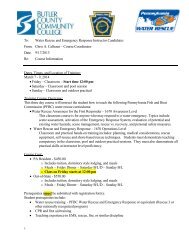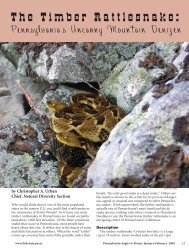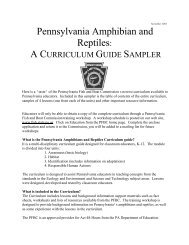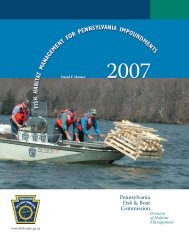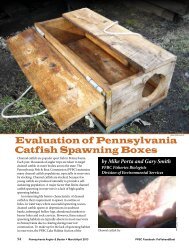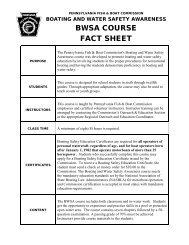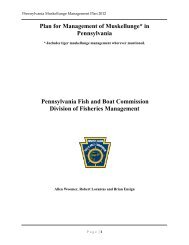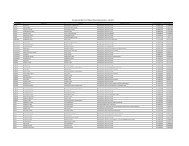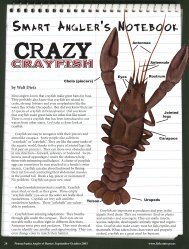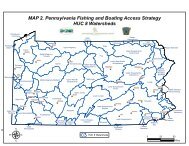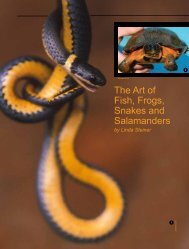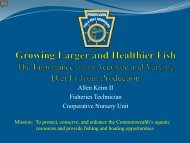march, 1968 - Pennsylvania Fish and Boat Commission
march, 1968 - Pennsylvania Fish and Boat Commission
march, 1968 - Pennsylvania Fish and Boat Commission
You also want an ePaper? Increase the reach of your titles
YUMPU automatically turns print PDFs into web optimized ePapers that Google loves.
w i<br />
m *<br />
SAFETY fliSJ<br />
T<br />
HEM<br />
EHJOV 111 YOURSELF'<br />
lUUMStLr 1 ^<br />
POSTER CONTEST WINNER Dave Westfall of Guys Mills<br />
<strong>and</strong> Elmer Wherry, committee chairman <strong>and</strong> publicity chairman<br />
for the contest, which is sponsored annually by the northwest<br />
division of the <strong>Pennsylvania</strong> Federation of Sportsmen's Clubs.<br />
Second place in the division went to R<strong>and</strong>y Gilson of New Casde.<br />
The contest is sponsored to promote outdoor safety.<br />
BUSY SEASON continued from page 15<br />
CARING FOR WALLEYE eggs on the incubating battery. Approximately<br />
20,000,000 walleye eggs are taken each spring with<br />
an overall hatch of about 80 percent. The eggs will hatch in<br />
approximately three weeks, when the water temperature is in<br />
the high 40's or low 50's. During this period constant care is<br />
needed to avoid silting, clumping <strong>and</strong> to siphon off the infertile<br />
eggs to avoid fungus.<br />
an extremely fertile body of water with a very high plankton<br />
production.<br />
After a week of incubation dead eggs start to appear <strong>and</strong><br />
float to the top where they are siphoned off. Careful<br />
measurements are made of the eggs left in the jar just before<br />
hatching <strong>and</strong> then these are compared with original<br />
volumes to determine percentage of hatch. This usually<br />
runs from between 70 <strong>and</strong> 90 percent under normal conditions.<br />
Incubation period varies with water temperature. Aver<br />
Retires<br />
James W. Starner,<br />
heavy construction foreman<br />
in the <strong>Pennsylvania</strong><br />
<strong>Fish</strong> <strong>Commission</strong>'s Engineering<br />
Division, has<br />
retired after 26 years<br />
service.<br />
Starner began work in 1941 at Huntsdale<br />
for the commission as a stone mason. Throughout<br />
his years with the commission he worked<br />
at times as a carpenter as well.<br />
The father of four children <strong>and</strong> gr<strong>and</strong>father<br />
of five he says he plans to spend the<br />
coming summer in California as well as some<br />
time in Florida during the winter mondis.<br />
age is twenty-one days with "eye up" occurring in ten to<br />
fifteen days. Usually water temperature is in the low 40's<br />
when incubation begins <strong>and</strong> gradually rises to the low 50's.<br />
Once hatching begins, it usually takes three days with<br />
the majority of eggs hatching on the second day. Screens<br />
are removed from the jars as soon as eggs begin to hatch<br />
<strong>and</strong> fry are allowed to go out into a supply trough <strong>and</strong><br />
then into holding tanks. When first hatched the fry are<br />
thin, nearly transparent, about three eighths of an inch<br />
long with little or no yolk sac. They swim up <strong>and</strong> feed<br />
almost immediately.<br />
Since the number of eggs taken would result in a much<br />
larger number of fry than could be maintained at this<br />
facility many of the eyed eggs are sent to other hatcheries.<br />
Immediately after hatching, a large percentage of the fry<br />
are stocked or transported to other hatcheries.<br />
The eyed eggs <strong>and</strong> fry are transported by air <strong>and</strong> truck<br />
in 12 inch by 12 inch plastic bags with one quart of water<br />
for every quart of eggs. Oxygen is provided when the bags<br />
are inflated <strong>and</strong> sealed. Fry are shipped the same way<br />
using two quarts of water for every 25,000.<br />
Fry which are held start feeding on zooplankton almost<br />
immediately <strong>and</strong> are soon transferred from holding tanks<br />
to previously prepared rearing ponds which have been<br />
fertilized <strong>and</strong> started with daphnia.<br />
As the daphnia are eaten a new supply is stocked from<br />
specially prepared daphnia rearing units <strong>and</strong> from Pymatuning<br />
Lake. Daphnia must be kept in constant supply or<br />
the fry will turn to cannibalism. Two day old fry have been<br />
observed in a chain effect head to tail when a proper food<br />
supply was not available.<br />
Fry are held in rearing ponds approximately five weeks<br />
until early June or until water temperature reaches 70<br />
degrees. By then they'll be between two <strong>and</strong> three inches<br />
long <strong>and</strong> are ready to be stocked.<br />
26 PENNSYLVANIA ANGLER




